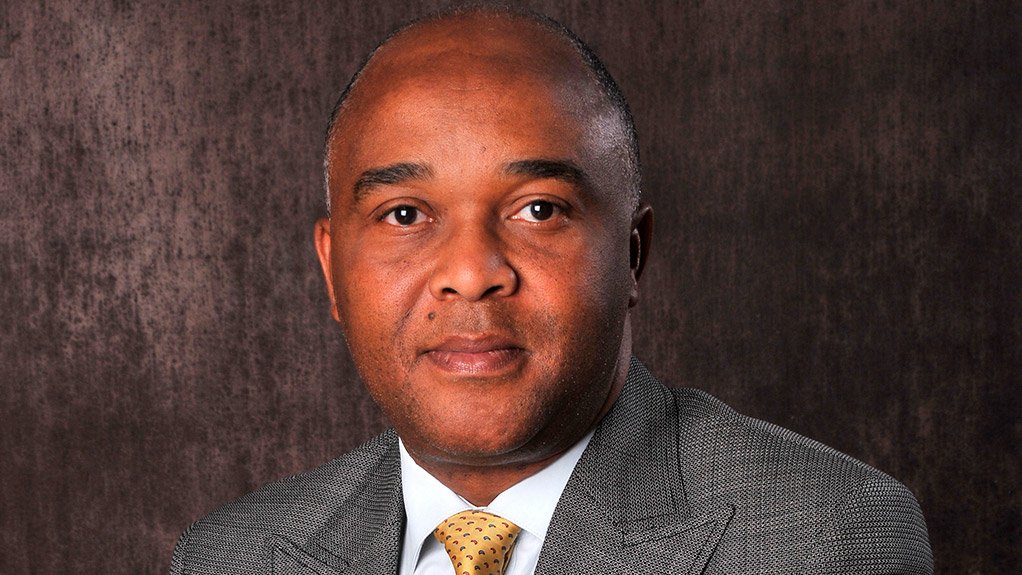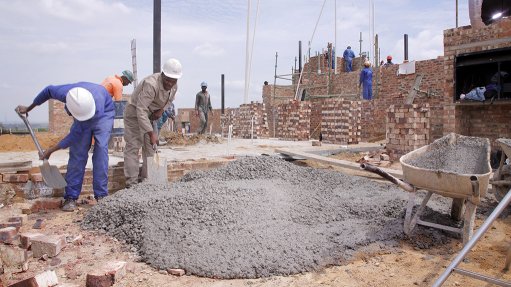Noko suggests more frequent home visits for migrant miners
JOHANNESBURG (miningweekly.com) – Consideration should be given to the restructuring of shifts to allow migrant mineworkers from distant areas to go home more frequently, says AngloGold Ashanti executive VP sustainability David Noko.
Noko, who has headed AngloGold’s social and sustainable development portfolio since June 2012, believes migrancy should be retained but radically reformed.
“What I see when I travel to other mining countries is that the employee migrancy is growing,” Noko comments to Mining Weekly Online.
“The challenge facing us in South Africa is our labour intensity. Our volumes are large but surely there is a solution somewhere through shift structures and quicker transport,” the former De Beers Consolidated Mines CEO says.
South Africa’s migrant mineworkers differ majorly from their world counterparts in that they are large in number, lowly paid and minimally educated, whereas global migrants are increasingly higher paid knowledge workers who generally benefit from fly-in, fly-out transport.
In contrast, South Africa’s migrants are hardly ever fully resident in the areas where they work and rarely present in the places they call home, with the current South African system of 11-shift fortnights and 12 days holiday a year seen as a negative factor.
The inability to attend adequately to the economic and social needs of migrant mineworkers is increasingly being seen as a major contributor to the mining industry’s current turmoil.
“I happened to be in Australia the whole of last week, visiting our operations there, and it was very interesting that the airport in Perth was a hive of activity, as it is every morning and evening, with fleets and fleets of aeroplanes flying out in different directions to where the mines are situated.
“Being the developed country that Australia is, that seemed to define the modern way of mining.
“You go to Canada, you see the same. The difference in some parts of South America like Brazil is that there is extended residence time on mines and people are not flying in and out as frequently.
“Australia and Canada have advanced their mineworkers into knowledge workers so it pays them to fly workers in and out and the shift structures are quite interesting. Six days in and four days out and when at the mining camps, they live in cubicles with a bed and bathroom.
“I stayed in one at both Tropicana and Sunrise Dam and they are quite compatible with a three-star hotel in South Africa,” Noko tells Mining Weekly Online.
Teba Limited CEO Graham Herbert believes that allowing mineworkers more time at home changes their mind-set while they are at work.
Teba, headed by executive chairperson Dr James Motlatsi, a former 40c-a-shift mineworker and founding president of the National Union of Mineworkers, has been investigating a number of initiatives on migrant labour reform, including the implementation in the short term of a new system of affording migrant mineworkers more time at home with their families in the labour-sending areas.
“Overall, the trend is towards giving mineworkers more time at home,” Herbert tells Mining Weekly Online.
“They are more likely to be productive. They want to go home with money because they want to do meaningful things when they get home. Apart from just contributing to family unity and stability, we are fully in favour of shift redesign,” he adds.
Noko says he would rather convert mine hostels into decent living space, but still keep the migrancy, “because its real and doesn’t leave you with a ghost town.
“What happens when the mine closes and you have made these communities permanent? While I have an aversion to hostels, I think there is a middle road here.
“I speak to our own employees and many tell me that their entire structure of living is rural and they don’t want to bring their families to live near the mine.
“I believe that we have to keep the migrancy and work towards converting our people from mineworkers into knowledge workers,” Noko says, adding that he would also like to see education bolt-ons at mines, the introduction of "academic mines" and a stronger link between the industry’s good training institutions and universities.
Wherever feasible, he would also like to see mine land used for agriculture.
Most deep-level mines produce significant volumes of water, which could go together with agricultural development.
China has also commissioned a plant that processes waste rock into paper and consideration could also be given to following suit.
The developed mining economies make use of optimal mechanisation and minimal labour.
“But I think the investment is the same as what we invest in high labour and minimal mechanisation,” says Noko.
While Tropicana and Sunrise Dams are in the Australian desert with the nearest communities 200 km away, in South Africa the situation is often different in that many mines are located where there are communities.
“Those who want to live local in Klerksdorp should be allowed to do so. But those who come from far-flung areas and neighbouring states and have no interest in moving their families to the mine, should be allowed to continue to be migrant workers living in improved living quarters.
“We need to be very mindful of unintended consequences, as with the paying of living-out allowances, which turned out to be disastrous. But we’ve also got to give people the latitude to be themselves. We can’t be prescriptive,” Noko comments to Mining Weekly Online.
Teba reports making good shift reform progress with companies including the JSE-listed gold-mining company Sibanye Gold, headed by CEO Neal Froneman.
The Teba view is that shift reform has the potential to facilitate a shared labour planning exercise that can reduce dependence on skilled mineworkers who live far away and provide an opportunity to develop skills around the mines.
“There are real cooperative benefits and, by the way, there are probably government rebates that will pay for all this,” says Herbert.
“We’re not going to reverse the migrant labour system with the 11-shift fortnight,” he says, adding that proper reform has the potential to reduce reliance on foreign mineworkers and shift that reliance to local, which will address the local unemployment problem.
On the issue of transport, Herbert says that mineworkers have for long been finding their own way home and back in taxis while Noko would like to see the rejuvenation of South Africa’s rail systems taking more cognisance of passenger needs so that mineworkers could make greater use of rail transport to get back home.
Other mining companies are considering bus options.
For mines close to established towns, opportunities are also being taken to work with local authorities to provide housing to allow workers to cease being migrants and enjoy vastly improved family lives by living closer to the mines, in water-served and electricity-reticulated dwellings.
“We need to begin to think outside of our hard-wired spaces and the language of social profits and social gains and mutual benefits and shared benefits needs to follow, to show that business is a two-way street.
“We need to think about social profits or social gains as a way of defining economic value. At this point we talk about economic profits to the exclusion of meeting societal needs. I think that shift needs to happen,” Noko comments to Mining Weekly Online.
As things stand, profits are calculated using hard-wired measurements that have not changed since the design of an income statement.
“Are they still relevant in the way they are fashioned? I don’t believe that they are. I believe they serve a particular need and if we continue to serve that need in a single-minded fashion, we are actually failing to address the continuity and livelihood of business in society,” he adds.
A comprehensive sustainability study being undertaken for AngloGold by the University of the Witwatersrand, the University of Tanzania and a specially commissioned social scientist is expected to be completed by the end of September.
Comments
Announcements
What's On
Subscribe to improve your user experience...
Option 1 (equivalent of R125 a month):
Receive a weekly copy of Creamer Media's Engineering News & Mining Weekly magazine
(print copy for those in South Africa and e-magazine for those outside of South Africa)
Receive daily email newsletters
Access to full search results
Access archive of magazine back copies
Access to Projects in Progress
Access to ONE Research Report of your choice in PDF format
Option 2 (equivalent of R375 a month):
All benefits from Option 1
PLUS
Access to Creamer Media's Research Channel Africa for ALL Research Reports, in PDF format, on various industrial and mining sectors
including Electricity; Water; Energy Transition; Hydrogen; Roads, Rail and Ports; Coal; Gold; Platinum; Battery Metals; etc.
Already a subscriber?
Forgotten your password?
Receive weekly copy of Creamer Media's Engineering News & Mining Weekly magazine (print copy for those in South Africa and e-magazine for those outside of South Africa)
➕
Recieve daily email newsletters
➕
Access to full search results
➕
Access archive of magazine back copies
➕
Access to Projects in Progress
➕
Access to ONE Research Report of your choice in PDF format
RESEARCH CHANNEL AFRICA
R4500 (equivalent of R375 a month)
SUBSCRIBEAll benefits from Option 1
➕
Access to Creamer Media's Research Channel Africa for ALL Research Reports on various industrial and mining sectors, in PDF format, including on:
Electricity
➕
Water
➕
Energy Transition
➕
Hydrogen
➕
Roads, Rail and Ports
➕
Coal
➕
Gold
➕
Platinum
➕
Battery Metals
➕
etc.
Receive all benefits from Option 1 or Option 2 delivered to numerous people at your company
➕
Multiple User names and Passwords for simultaneous log-ins
➕
Intranet integration access to all in your organisation





















